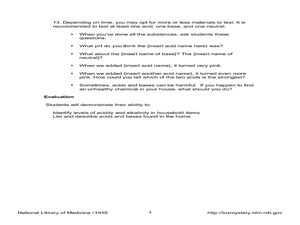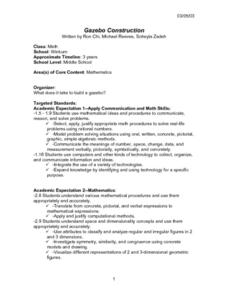Curated OER
Language in Classroom Texts
Learners research printed material found in a school setting, looking for examples of bias, gender equity or distortion, discrimination and stereotyping.Students work in pairs to develop suggestions for strategies to address bias they...
Curated OER
Developing a Theory About the Nature of the Contents of a Sealed Box
Students observe the changes of a closed chemical system. They record and analyze the data as they manipulate the system. They answer questions to end the instructional activity.
Curated OER
One Person's Garbage, Another Person's . . .?
Young scholars list many, different and unusual items that could be constructed out of refuse and found objects.
Curated OER
Acid or Base? Toxie's on the Case
Students recognize the difference between acids and bases. In this ToxMystery lesson, students play a computer game and experiment to find the difference between acids and bases. Students use litmus paper to determine if household...
Curated OER
Creating the Ideal Cargo Boat
Students build boats out of clay to test the buoyancy of the boat in water. Students break into pairs and construct their boat to specific guide lines, then experiment with their boat in the water.
Curated OER
Pollution Solution
Young scholars explore the concept of environmental stewardship. In this science lesson, students investigate the effects of oil spills and brainstorm ideas to help companies avoid them as they create models to demonstrate their...
Curated OER
Topics and Ideas -- Sort and Seize
Learners examine the writing process. They determine the needs of the readers of their story before writing. They use peer-editing to check for errors and read their story to the class.
Curated OER
A Creative Classroom Model For a Sixth Grade Science Class
Sixth graders observe with a microscope such simple crystals as salt, sugar, cream of tartar, and other chemicals which are listed in detail. They observe the crystalline structure and make comparisons, culminating in the creation of...
Curated OER
Historic Earth Science Innovations
Young scholars research the demands or limitations on Earth scientists. In groups, they design and build a model that would be useful to them in the lab or field. They share their model and their ideas behind it to the class and answer...
Curated OER
Dancing and Singing Through the Bill of Rights
Students study the Bill of Rights. In this Bill of Rights lesson, students read and analyze the Bill of Rights before performing The Amendment Song, and a dance associated with the concepts. They work in small groups using a Frayer...
Curated OER
Understanding Radios
Fifth graders explore ratios. Using models and real-world scenarios, they complete tables and generate comparisons. Pupils demonstrate multiple ways of writing ratios and describe the differences between ratios.
Curated OER
Gazebo Construction
Students create and give oral proposals for the construction of a gazebo using a blueprint created with Geometer's Sketchpad. They then build a gazebo model using the blueprints created and provide evidence why it should be selected for...
Curated OER
Structure of the Earth
Eighth graders describe and identify the three layers of the Earth. They work together to construct their own earth model. They share their creation with the class.
Curated OER
Introduction to Fractals: Infinity, Self-Similarity and Recursion
Students think about several of the concepts from fractals, including recursion and self similarity. They use mathematical concepts of line segments, perimeter, area and infinity are used, and skill at pattern recognition is practiced.
Curated OER
Leonardo Lives
Students investigate the concepts of force and motion. They describe how motion is created by force. Also students define a simple machine and the factors of application to creating force or motion. They analyze the plans of Leonardo De...
Curated OER
Visualizing Density: Density is Non-obvious
Students explore models of density; wooden balls and marbles discussing whether they think the volume and mass are the same or different. They then compare the density of a loaf of bread that is squished and one that is not compressed.
Curated OER
All Hands on Deck: A Harbor Education Program
Students build a model of an estuary. For this wetland lesson, students build a model estuary with a paint tray and modeling clay. They use the model to illustrate the impact of non-point pollution on the watershed.
Curated OER
Earth's History
Seventh graders study the law of superposition by creating models of fossils in layers of rock. They examine how fossils are usually found in sedimentary rock which leads to the study of geologic history in those rocks.
Curated OER
Ist's Yours- It's Mine
Students investigate the concept of having an income as part of an economic system. They use the circular flow model to describe monetary policies. Students explain how policies of government influence the redistribution of income and...
Curated OER
Creative Expressions--Protein Synthesis
Students explore protein synthesis through creative expression. They constructa three dimensional, move-able model of protein synthesis depicting all of the processes involved, from replication to the production of the protein.
Curated OER
Laws of Motions
Seventh graders explore the Laws of Motion. They define friction and explain the concept of inertia. Students explain what happens when a force is exerted on an object that is in equilibrium. They state the second and third laws of motion.
Curated OER
Introduction to Toxicology
Students explore the science of toxicology and the relationship between a toxic reaction (response) and amount of substance (dose). They observe two demonstrations illustrating the concept of dose-response.
Curated OER
Can You Control Floods
Students assume the role of an engineer or planner. As an engineer or planner they must come up with ideas that can be put into place to control floods. They produce a working model of flood control.
Curated OER
Color Principles - Hue, Saturation, and Value
Students identify different color models and the application of the color theory. They create different visualizations that compare color models.























